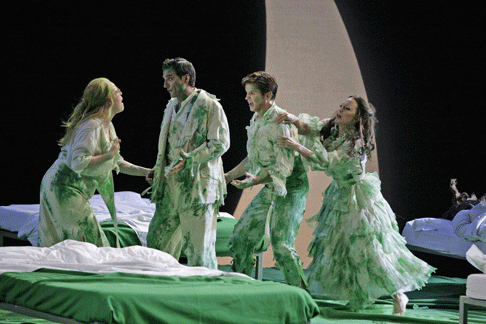It has a long history; it was a major hit of the 1991 Aix-en-Provence Festival International d’Art Lyrique. The rich and costly staging was then co-produced with the OpÈra Nationale de Lyon. In the last 18 years, it has traveled to many countries; in Italy, in the 1990s, it had a few performances at the Ravenna Festival and Ferrara Musica. In both towns the opera house is comparatively small and the stage not much larger that that of Aix-en-Provence. Carsen has reviewed and updated the staging many a time. Further stagings are now programmed all over Europe and, supposedly, in the USA.
The opera itself had been conceived for a specific event: the reconstruction, in 1960, of the Jubilee Hall in Aldelburgh, where Britten and his lifetime partner, the tenor Peter Pears, were living. Even though the reconstruction implied an increase in space, the Hall could accommodate no more than 316 people. It had a simple wooden stage (with no modern machinery or equipment), the pit was designed for a small orchestra (nearly a chamber music ensemble), although the opera required 18 soloists and a children chorus. At that time, Britten was working on a project to reduce the cost of opera productions and to make them transportable from town to town; he thought that this was the only feasible strategy to make opera survive in the post- World War II era. As a part of this strategy, in 1945, he gave a new start to the Glyndebourne Festival in Sussex, and in 1947 he created the English Opera Group – a touring company with limited means to bring opera even to small towns of the UK, Switzerland and the Netherlands. Some of his operas (“The Rape of Lucretia”, “Curlew River”, the Church musical pieces) were composed for this project. Even his attempt at “grand opera,” “Billy Budd,” had also a version with only two pianos and a slightly reduced number of soloists.
Against this backdrop, the Scala “A Midsummer Night’s Dream” is a departure from Britten’s chamber opera yet still far from his two forays into “grand opera” (“Gloriana”, in addition to “Billy Budd”) . Britten’s writing is eclectic; it is rooted in the British tradition since Purcell but it incorporates also Berg’s technique of adopting a theme on which to build each individual musical scene, though Britten does not turn his back on a tonal approach. Another aspect – especially relevant to “A Mid-Summer”- is his capacity to obtain colour from a small orchestral ensemble and the counterpoint of a large number of vocal soloists. Finally, in “Midsummer,” he explores the magic of the night and assigns to the fairies the most “unearthy” vocal register: a coloratura soprano (Tytania) and a counter-tenor (Oberon).
After 18 years, the production is still fresh. Carlsen, then very young, saw “A Midsummer” as an exploration of eroticism – from that of the very young (the two fugitive couples) to that of the adult (Tytania and Oberon) to that of the peasants. The set is wide green with beds (two huge ones in the first act, six “queensize” in the second act, and three, suspended above the stage, in the first part of the third act) until the final scene in a white but dull Athens.

Sir Andrew Davis conducted a chamber music ensemble: two harps, a harpsichord, a small number of violins and cellos, brass and percussion. The small orchestra performance is the best part of the performance, the crystal-clear and transparent texture is a real thrill. A mostly British cast gave excellent acting performances. The Rosemary Joshua sang a sexy “coloratura” Tytania, and quite good also were the two young couples (Gordon Gietz, David Adam Moore, Deanne Meek and Erin Wall). David Daniels is a virtuoso countertenor but his volume is better suited to a small concert house than to the large La Scala auditorium (where the acoustic is less than perfect).
Giuseppe Pennisi
image=http://www.operatoday.com/Midsummer_LaScala_01.gif
image_description=David Daniels as Oberon and Rosemary Joshua as Tytania
product=yes
product_title=Benjamin Britten: Midsummer Night’s Dream
product_by=Oberon: David Daniels; Tytania: Rosemary Joshua; Puck: Emil Wolk; Theseus: Daniel Okulitch; Hippolyta: Natascha Petrinsky; Lysander: Gordon Gietz; Demetrius: David Adam Moore; Hermia: Deanne Meek; Helena: Erin Wall; Bottom: Matthew Rose; Quince: Andrew Shore; Flute: Christopher Gillett; Snug: Graeme Danby; Snout: Adrian Thompson; Starveling: Simon Butteriss; Cobweb: Francesca Mercuriali; Peaseblossom: Elena Caccamo; Mustardseed: Barbara Massaro; Moth: NicolÚ De Maestri. Conductor: Sir Andrew Davis. Stage Direction: Robert Carsen. Set and Costumes: Michael Levine. Lighting: Davy Cunningham. Choreography: Matthew Bourne. Orchestra del Teatro alla Scala.
product_id=Above: David Daniels as Oberon and Rosemary Joshua as Tytania